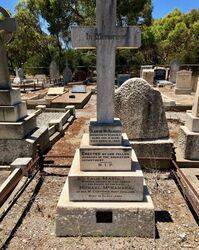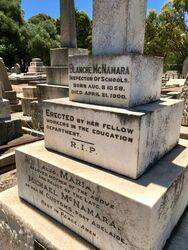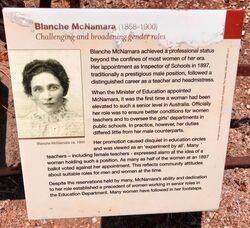
Blanche McNamaraPrint Page 
The monument over the gravesite commemorates Blanche McNamara (1858 - 1900), who was Australia’s first woman inspector of state schools in 1897. Her appointment was resisted by the males who had dominated as heads of state schools, while most teachers were women, after education became compulsory in 1875.
In 1875, Blanche McNamara became a pupil teacher at Rundle Street School in the city. Her first appointment in 1879 was to the girls' department of Le Fevre Peninsula Public School. In 1883, she was appointed first assistant in the girls’ department of the prestigious North Adelaide Model School, and was promoted to headmistress at Port Adelaide school in 1890 – in charge of the girls’ and infant departments but subordinate to the headmaster.
As a result of South Australian women getting the vote in 1895, the Government began appointing a few women to important public offices. In 1897, the education minister John Cockburn announced that one of the two vacancies for state school inspectors would be for a woman.
Blanche McNamara’s appointment was surprising as she was most junior headmistress in the education department. She was required to report on the women students at the teachers’ training college, the Advanced School for Girls and the girls’ and infant departments in 25 city and suburban schools. She also visited some south-east country schools.
McNamara’s time as an inspector was brief. She contracted tuberculosis in 1898 and died in 1900.
THE LATE MISS McNAMARA. Widespread regret was occasioned on Saturday, especially in the Education Department, by the news of the death of Miss Blanche McNamara, who had for the last three years filled the position of lady inspector of schools. The cause of death was consumption, from which Miss McNamara though seldom obliged to absent herself from duty. She had the distinction of having been the first lady inspector appointed in South Australia. Miss McNamara was a daughter of the late Mr. McNamara, formerly an officer in H.M. Customs at Port Adelaide.
She first entered the service as a pupil teacher in the Rundle-street school in 1875, and her educational career was successful from the first. She became head-mistress of the girls' department at Port Adelaide in January, 1889. This post she retained until promoted to the newly-created office of lady inspector in 1897. Mr. L. W. Stanton. the chairman of the Board of Inspectors, speaks of the deceased lady in highly eulogistic terms. She had discharged the duties of her office with marked ability and judgment, and was universally held in high esteem.
Chronicle (Adelaide), 28 April 1900.
Location
| Address: | 161 West Terrace, West Terrace Cemetery, Wylde Road, Adelaide, 5000 |
|---|---|
| State: | SA |
| Area: | AUS |
| GPS Coordinates: | Lat: -34.932264 Long: 138.584974 Note: GPS Coordinates are approximate. |
Details
| Monument Type: | Grave |
|---|---|
| Monument Theme: | People |
| Sub-Theme: | Education |
| Link: | https://adelaideaz.com/articles/hea… |
Dedication
| Approx. Monument Dedication Date: |
|---|
Blanche McNamara
Inspector of Schools.
Born Aug, 8 1858,
Died April 21. 1900.
Erected by her fellow workers in the Education Department.
R. I. P.
Also, Maria,
Beloved mother of the above and relict of the late Michael McNamara of Her M. Customs , Port Adelaide.
Rest in peace, Amen.
Blanche McNamara (1858 - 1900)
Challenging and broadening gender roles
Blanche McNamara achieved a professional status beyond the confines of most women of her era. Her appointment as Inspector of Schools in 1897, traditionally a prestigious male position, followed a disntinguished career as a teacher and headmistress.
When the Minister of Education appointed McNamara, it was the first time a woman had been elevated to such a senior level in Australia. Officially her role was to ensure better conditions for women teachers and to oversee the girls` departments in public schools. In practice, however, her duties differed little from her male counterparts.
Her promotion caused disquiet in education circles and viewed as an `experiment by all`. Many teachers - including female teachers - expressed alarm at the idea of a woman holding such a position. As many as half of the women at an 1897 ballot voted against her appointment. This reflects community attitudes about suitable roles for men and women at the time.
Despite the reservations held by many, McNamara`s ability and dedication to her role established a precedent of working working in senior roles in the Education Department. Many women have followed in her footsteps.







